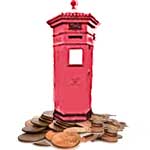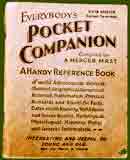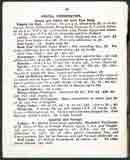Postage costs early-mid 20th Century UK

Postage costs in the UK in the early-mid 20th Century were determined by weight rather than shape, volume or speed of delivery. This page analyses a document from c1933-1942 which shows the different types of postal rates for different letters and packages for inland and overseas. The size of the inflation between then and now will astound you.
____
By the webmaster, based on document analysis
Postage costs were by weight rather than shape, volume or speed of delivery. There was no First or Second Class. As special recognition of the Empire (and possibly also the emerging Commonwealth), postage by Sea Mail anywhere there cost the same as within the UK.
Postal rates published in the Pocket Companion c1933-1942
Left: The Pocket Companion which quotes the postage rates.
Right: Postage rates for sometime between 1933 and 1942. Tap/click for a larger legible
image or see below for a text transcription.
It is worth tap/clicking to magnify the postal rates image, not only to see the prices, but also to note how punctuation has changed over the years. Whereas we might put a full stop only at the end of a complete sentence, full stops were placed at the end of phrases and headings. Also note the names of countries that no longer exist or have been renamed, and of course notice the old, pre-decimal money.
Transcription of the The Pocket Companion page on postage costs
I have done my best to transcribe the words, punctuation and structure exactly as in the original which does emphasise the punctuation which today would be regarded as excessive and haphazard. Remember that each individual letter and symbol had to be separately typeset and that the typesetter probably didn't have a complete understanding of what he (yes he) was having to do.
POSTAL INFORMATION.
Inland and within the Irish Free State.
Empire Air Mail. Letters, 6d. per ½ oz. (Postcards 3d.) to India, Ceylon, Straits Settlements, Hong Kong, Sarawak, E.C. and S. Africa. 3d. per ½ oz. (P.C's. 2d.) to Palestine, Iraq, Persia, Egypt and Sudan. Is. 3d. per ½ oz. (P.C's. 6d.) to Australia and New Zealand.
Letters - Not over 2oz., 1½d. Every additional 2oz. or part, ½d.
Irish Free State. - 3oz. 2d. For every additional oz. ½d.
Post Cards. - 1d. Reply paid, 2d.
Book Post (Printed Paper Rate). - Not exceeding 20z. ½d. For every additional 2oz. or fraction of 2oz., ½d. up to 21b.
Irish Free State. - 1oz. ½d. ; 2oz. 1d.
Newspapers. - (Registered). - 1d each copy not over 6oz. ; ½d. each additional 6oz. up to 2lb. ; (unregistered) same as printed matter.
Samples. - (Not I.F.S.). To 4oz. 1d ; to 6ox. 1½d.; to 8oz., (limit) 2d.
Parcels. - Up to 31b., 6d. ; 41b., 7d. ; 5lb., 8d. ; 61b. 9d.; 7lb., 10d.; 8lb.,11d. ; 9lb. to 15lb. (maximum weight) 1/- . Size limit, length 3ft. 6ins., length and girth combined, 6ft.
Cash on Delivery Service. - Used for the remittance of the value of an article sent by Parcel Post. The fees (over and above the ordinary parcel postage) are for a trade charge of 10s. 4d. ; £1, 6d. ; £2, 8d.; £5, 10d.; and 2d. extra for each £5 or fraction up to £40.
Express Delivery. - 6d. a mile.
Money Orders (Ordinary). - Not over £3, 4d. ; £10, 6d. ; £20, 8d. £30, 10d. ; £40, 1s (limit).
Money Orders (Telegraph). - Same commission as above plus fee of 2d. and cost of telegram.
Postal Orders. - 6d. to 2/6, 1d. ; 8/- to 15/-, 1½ d.; 15/6 to 21/-, 2d.
Telegrams. - 9 words, 6d. (to and within I.F.S., 12 words, 1/6). Every additional word, 1d. Names and addresses charged for. Free delivery within 3 miles. 6d. a mile beyond.
Imperial and Foreign.
Letters. - To British Possessions generally, Mandated Territories, H.M. Ships of War in Foreign Waters, Egypt, U.S.A. and Tangier, 1½d. per oz., every additional oz. 1d. (I.F.S.- 1oz. 2d. ; every additional oz. 1½d.). To all other places (including Iraq and Transjordania), 2½d. for the first oz., and 1½d. for each additional oz.
Post Cards. - To British Possessions, as above, 1d. To other places abroad, 1½d, each.
The date of the The Pocket Companion booklet
The booklet was undated, but its date can be estimated as between 1933 and 1945: It gives a list of presidents of the USA, the latest of whom was President Roosevelt. Since he was in office between 1933 and 1945, that dates the booklet to between these dates. Also as the booklet was almost certainly bought by my grandfather who died in 1942, the booklet must have been produced between 1933 and 1942.
I have no information on how postage rates changed during these years, but offer the booklet for your interest. You may like to look at the postage stamps page to gain an estimate, as the price of the stamps is written on them. The economy mail page considers air mail postage.
Inflation
You may like to compare these costs with those of today. As I write in 2023, it costs £1.10 to post an ordinary letter 1st class.
How's this for postage inflation!?
Based on a letter in The Daily Telegraph 08/12/20
On January 1 1937 a postage stamp to send a letter was equivalent to one penny in today's money, [tuppence ha'penny, i.e. two pennies and a half penny in old money]. On January 1 2020 it was 85p First Class.
In the past of course, the vast majority of communication was by letter whereas now relatively few letters are sent. Consequently the Post Office has had to increase its prices to maintain its income.
So, as always, it is not straightforward to calculate inflation on the basis of a particular price increases.
| sources | webmaster | contact |
Text and images are copyright
If you can add anything to this page or provide a photo, please contact me.





